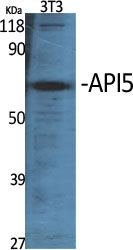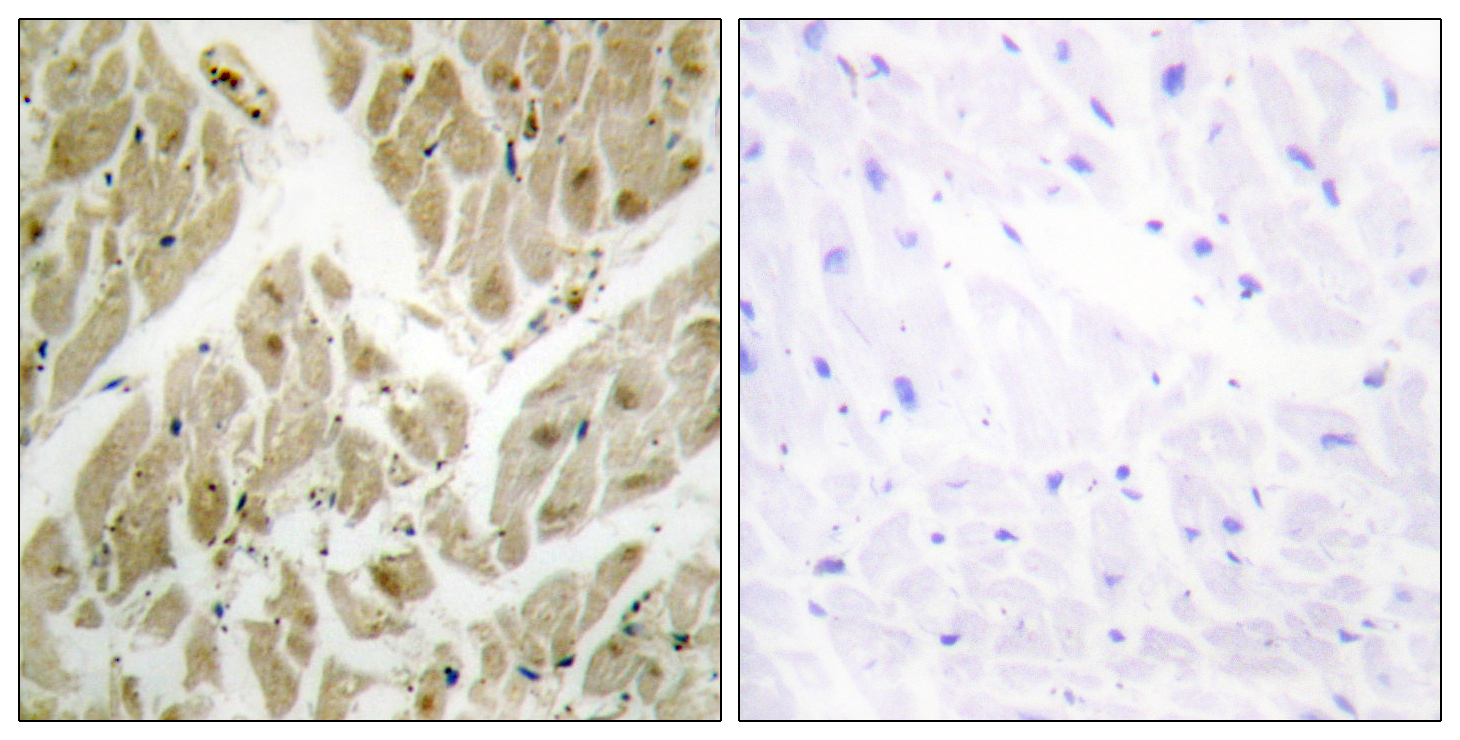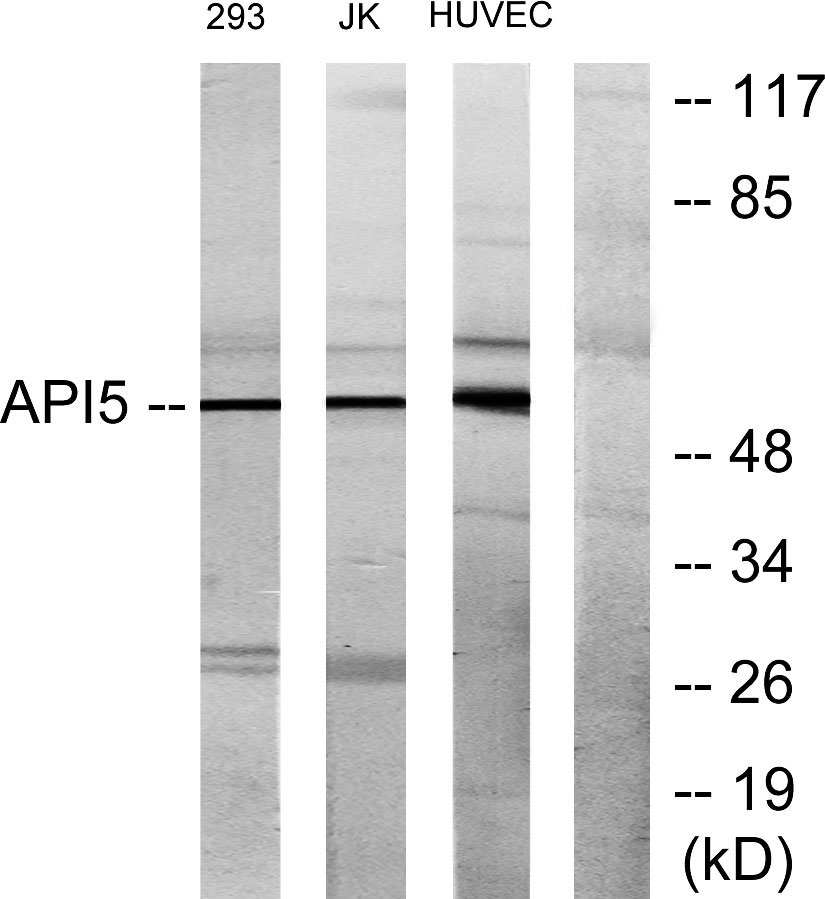API5 Polyclonal Antibody
- Catalog No.:YT0264
- Applications:WB;IHC;IF;ELISA
- Reactivity:Human;Mouse
- Target:
- API5
- Gene Name:
- API5
- Protein Name:
- Apoptosis inhibitor 5
- Human Gene Id:
- 8539
- Human Swiss Prot No:
- Q9BZZ5
- Mouse Gene Id:
- 11800
- Mouse Swiss Prot No:
- O35841
- Immunogen:
- The antiserum was produced against synthesized peptide derived from human API-5. AA range:421-470
- Specificity:
- API5 Polyclonal Antibody detects endogenous levels of API5 protein.
- Formulation:
- Liquid in PBS containing 50% glycerol, 0.5% BSA and 0.02% sodium azide.
- Source:
- Polyclonal, Rabbit,IgG
- Dilution:
- WB 1:500 - 1:2000. IHC 1:100 - 1:300. ELISA: 1:20000.. IF 1:50-200
- Purification:
- The antibody was affinity-purified from rabbit antiserum by affinity-chromatography using epitope-specific immunogen.
- Concentration:
- 1 mg/ml
- Storage Stability:
- -15°C to -25°C/1 year(Do not lower than -25°C)
- Other Name:
- API5;MIG8;Apoptosis inhibitor 5;API-5;Antiapoptosis clone 11 protein;AAC-11;Cell migration-inducing gene 8 protein;Fibroblast growth factor 2-interacting factor;FIF;Protein XAGL
- Observed Band(KD):
- 58kD
- Background:
- This gene encodes an apoptosis inhibitory protein whose expression prevents apoptosis after growth factor deprivation. This protein suppresses the transcription factor E2F1-induced apoptosis and also interacts with, and negatively regulates Acinus, a nuclear factor involved in apoptotic DNA fragmentation. Its depletion enhances the cytotoxic action of the chemotherapeutic drugs. Multiple alternatively spliced transcript variants encoding different isoforms have been identified. [provided by RefSeq, Aug 2011],
- Function:
- alternative products:Additional isoforms seem to exist,domain:Two regions, an N-terminal (aa 96-107) and a C-terminal (aa 274-311) are required for binding FGF2.,function:Antiapoptotic factor that may have a role in protein assembly. Negatively regulates ACIN1. By binding to ACIN1, it suppresses ACIN1 cleavage from CASP3 and ACIN1-mediated DNA fragmentation. Also known to efficiently suppress E2F1-induced apoptosis. Its depletion enhances the cytotoxic action of the chemotherapeutic drugs.,sequence caution:Translation N-terminally shortened.,similarity:Belongs to the API5 family.,subcellular location:Mainly nuclear. Can also be cytoplasmic.,subunit:Homooligomer. Interacts with FGF2 and ACIN1.,tissue specificity:Expressed in all tissues tested, including heart, brain, placenta, lung, liver, skeletal muscle, kidney and pancreas. Highest levels in heart, pancreas and placenta. Highly expres
- Subcellular Location:
- Nucleus . Cytoplasm . Mainly nuclear. Can also be cytoplasmic.; [Isoform 3]: Cytoplasm.
- Expression:
- Expressed in all tissues tested, including heart, brain, placenta, lung, liver, skeletal muscle, kidney and pancreas. Highest levels in heart, pancreas and placenta. Highly expressed in several cancers. Preferentially expressed in squamous cell carcinoma versus adenocarcinoma in non-small cell lung cancer.
- June 19-2018
- WESTERN IMMUNOBLOTTING PROTOCOL
- June 19-2018
- IMMUNOHISTOCHEMISTRY-PARAFFIN PROTOCOL
- June 19-2018
- IMMUNOFLUORESCENCE PROTOCOL
- September 08-2020
- FLOW-CYTOMEYRT-PROTOCOL
- May 20-2022
- Cell-Based ELISA│解您多样本WB检测之困扰
- July 13-2018
- CELL-BASED-ELISA-PROTOCOL-FOR-ACETYL-PROTEIN
- July 13-2018
- CELL-BASED-ELISA-PROTOCOL-FOR-PHOSPHO-PROTEIN
- July 13-2018
- Antibody-FAQs
- Products Images

- Western Blot analysis of various cells using API5 Polyclonal Antibody diluted at 1:1000
.jpg)
- Western Blot analysis of HuvEc cells using API5 Polyclonal Antibody diluted at 1:1000

- Immunohistochemistry analysis of paraffin-embedded human heart tissue, using API-5 Antibody. The picture on the right is blocked with the synthesized peptide.

- Western blot analysis of lysates from 293, Jurkat, and HUVEC cells, using API-5 Antibody. The lane on the right is blocked with the synthesized peptide.



